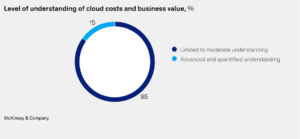The cloud is undoubtedly the cornerstone of digital transformation, allowing businesses to innovate, evolve, and keep pace with the competition. But to truly succeed with the cloud, we need to ensure our investment is working for us – and that starts with recognising key cloud spending pitfalls.
Who doesn’t love the cloud? Standing at the forefront of many modern business strategies, cloud technology has enabled us to add efficiency, agility, and flexibility to the way many of us work. As with any technological investment, however, we want to make sure we’re getting a solid return from the cloud. This is an especially impactful challenge thanks to the way cloud technology can sprawl, with resources being consumed, instances being spun up, and costs spiralling right under everybody’s nose. If not managed effectively, the cloud becomes a complicated and convoluted burden on the business. It’s not all doom and gloom, however. There are some common cloud spending pitfalls whose remediation, when identified correctly, can pre-empty many cloud-based woes.
Below we’ve selected some of the most common pitfalls we’ve identified using Surveil for Azure’s actionable insights:
Not reviewing bills and usage reports: Neglecting to regularly review bills and usage reports can lead to missed cost-saving opportunities, and therefore increased business spend. Without a thorough review of these reports, it’s easier than you’d think to miss inefficiencies, unused resources or unexpected spikes in usage that could lead to unnecessary spend. Ensuring regular checks over these reports and bills can allow you to identify trends and, as a result, optimise resource allocation and save costs.
Not optimising resources: Wasting money on resources that could be allocated more efficiently is a common cloud spending pitfall that many businesses fall victim to. When resources are provisioned in the cloud, they come at a cost, and this cost can quickly snowball out of hand if allocated resources are not tailored specifically to your business workflow. Optimising resource allocation not only reduces cost but can promote a more sustainable approach to cloud usage.
Security issues: Misconfigurations in a newly built (or neglected) cloud infrastructure can expose sensitive business data and create vulnerabilities across the cloud. The aftermath of a security incident can involve some expensive costs to both investigate and recover from the breach. It is essential that robust security measures and frequent training is put into place across your business to avoid these security issues, and in addition, the costs that come with a clean-up.
Spotting Cloud Spending Pitfalls with FinOps
You may have heard the term ‘FinOps’ being thrown around more and more, and there’s good reason for it. FinOps practices can decrease – and often completely avoid – the chances of falling prey to common cloud spending pitfalls such as the ones listed above.
The ultimate goal of FinOps is to enable businesses to derive business value from cloud. With only 15% of companies having a comprehensive understanding of their cloud environment, FinOps is a great fix to get deeper knowledge of what is happening behind the scenes.
By embracing FinOps to optimise resource allocation and costings, businesses are able to do a lot more with less, ensuring an ROI on their cloud investment while really maximising what the technology has on offer.
Not only does this drive efficiency and make the finance department happy, it also aligns with eco-friendly practices by reducing waste, energy consumption, and the carbon footprint—a win-win for both businesses and the planet. Mastering the art of cloud optimisation, including FinOps principles, is no longer just a choice; it is a necessity to thrive in this ever-evolving digital era, where financial efficiency and sustainability go hand in hand.
Meanwhile, by adopting a FinOps approach, your departments will be able to collaborate efficiently to pre-empt those cloud spending pitfalls, stopping the sprawl and the spiralling spend before they become a problem. Nice and simple.
Don’t know where to get started with FinOps? Surveil’s insights can empower your FinOps strategy with the right actionable insights. Get in touch today to arrange a demo!







